Navigate App Monetization: Strategies for Success | Mobio Group
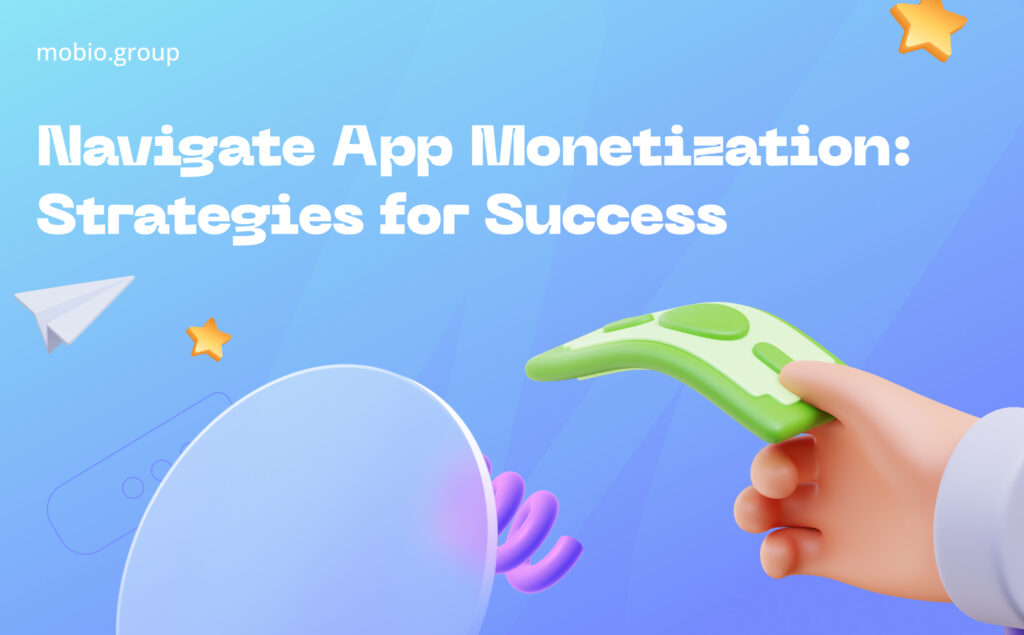
Planning and implementing an effective monetization strategy is the most important factor for successful mobile app promotion. Choosing a monetization model from the earliest stages of development affects various aspects of the app, including its layout, complexity, features, and promotion tactics. In this article, the Mobio Group team will discuss the main ways of monetizing mobile apps and choosing the best model to maximize revenue.
Monetization is the art of generating revenue from mobile apps. This complex process involves a number of strategies and techniques that are used to generate revenue.
Naturally, developers and owners first think about the conceptual basis of the app — this is certainly an important aspect. However, creating a quality mobile app requires a significant investment of time, effort and financial resources. Therefore, ensuring profits sufficient to cover the costs of development, maintenance and promotion is of paramount importance. At the same time, the ultimate goal is not just financial equilibrium, but profitability.
It is worth noting that the timeframe for success in mobile can vary greatly. Some apps quickly reach a broad level of profitability after launch, while others take years to flourish. Some apps fail from the very beginning. The result depends not only on the quality of the product, but also on how well the owners approached monetization from the very beginning, choosing the optimal model.
Paid Apps
Nowadays, most apps on the market are categorized as free-to-play. However, this was not always the case. In the early days of Google Play and the App Store, paid apps dominated the market. Times have changed and Statista’s data emphasizes the prevalence of free apps in the market, indicating that users are used to downloading apps without any upfront costs.
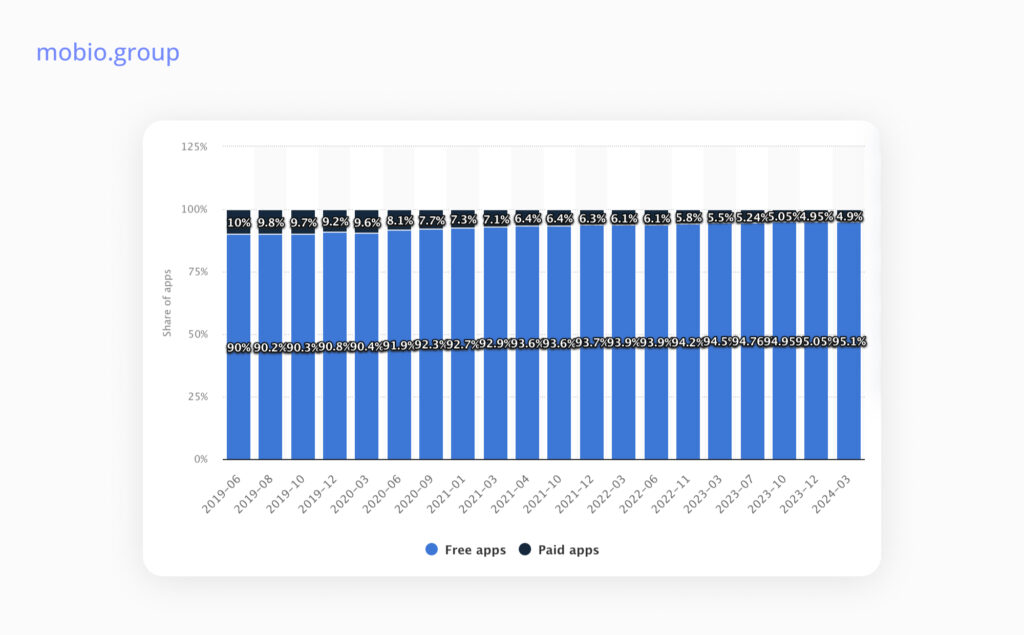
Source: Statista
The decision to launch a paid app usually depends on a variety of factors, including the features of the app, the amount of resources invested in its creation, and the level of ongoing support and updates required for continuous maintenance. Market positioning, competitive landscape, target audience and perceived benefits are extremely important for paid apps, but the main thing that paid apps must possess is exclusivity and a high level of quality.
The main categories of expensive paid mobile products are encyclopedic, medical, professional and diagnostic apps, as well as VIP “millionaire apps” (e.g. iVIP Black).
In-App Purchases
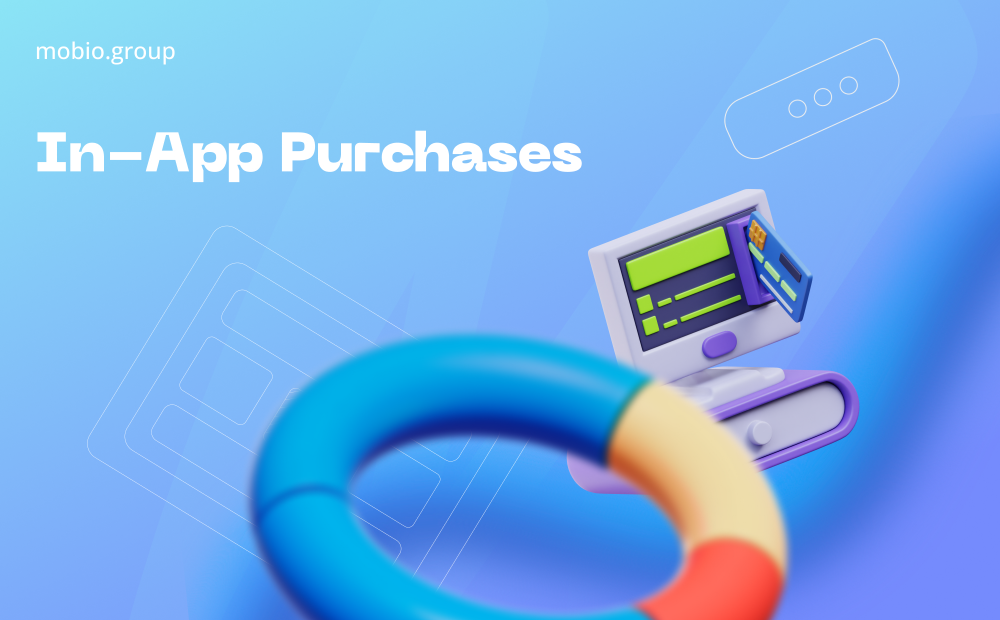
In-app purchases are the cornerstone of monetization: according to Business of Apps, 79% of mobile apps rely on them. In this freemium product economy, users install and use the app for free, but have the option to purchase various items, features or content within the app itself.
The mechanics of in-app purchases are relatively simple. Users browse a virtual app store where they can purchase various items or benefits. These could be extra lives or bonuses in gaming apps, premium filters and features in photography apps, or access to exclusive content in media apps. Some bonuses can be purchased exclusively with real money, while others can be purchased with the app’s internal currency.
The applicability of the in-app purchase model applies to different categories of mobile apps:
- Game apps in-app purchases are very common in mobile games and allow users to improve gameplay, unlock levels or purchase virtual items.
Clash of Clans — allows players to buy in-game currency (gems) to speed up building and unlock items. Fortnite — offers cosmetic skins, emotes, and battle passes for purchase to enhance the player’s appearance and game experience.
- Performance and utility apps — offers additional features, tools or content through in-app purchases to enhance the user experience.
Scanner Pro — allows users to purchase in-app credits to unlock OCR (optical character recognition) features for scanned documents.
- Photo and video editing apps provide premium filters, effects and editing tools as in-app purchases.
Facetune — allows users to purchase features such as teeth whitening and background blurring to enhance photos.
- Music and audio apps offer premium content, ad-free listening, or enhanced features with in-app purchases.
GarageBand — the store offers downloadable sound packs and virtual music creation tools.
- Art and creativity apps offer tools or exclusive content.
Procreate — provides access to premium brushes and layers through in-app purchases.
- Educational apps offer additional features for purchase such as advanced statistics, customized learning plans, test taking or offline content.
Gujarati kids Learning App — the store offers educational mini-games at different levels.
The in-app purchase model is almost universal across app categories, allowing users to customize their experience and access premium content or features tailored to their interests and needs.
Subscriptions
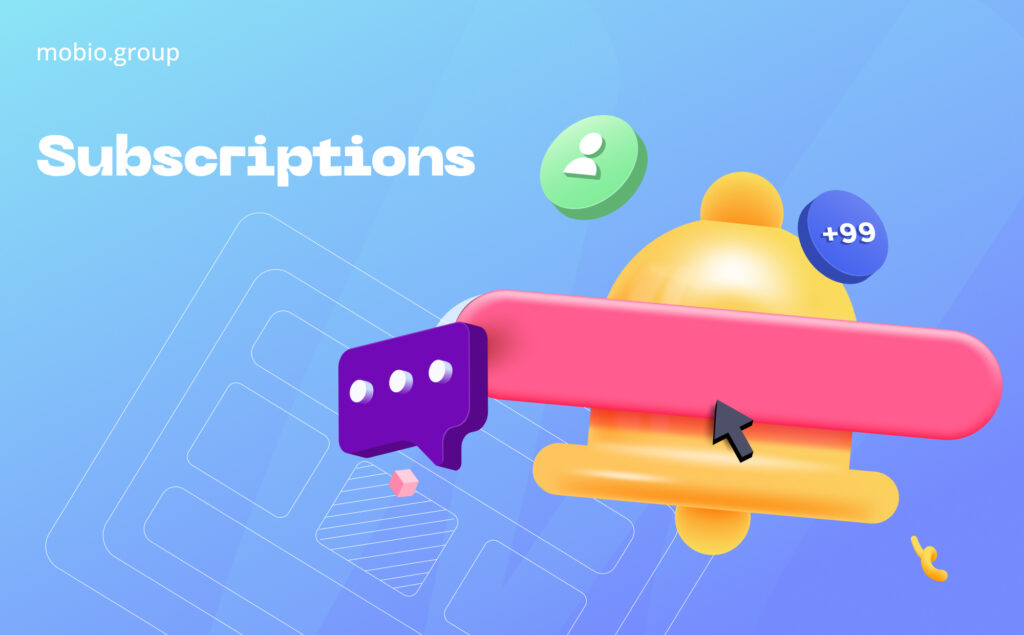
In mobile, subscriptions are a subset of in-app purchases that has become so influential that it now deserves recognition as a monetization model in its own right.
Subscriptions in mobile apps involve a purchase that gives users access to premium features, content, or services. To gain or retain this access, users must pay a set fee. Regular fees are typically weekly, monthly, or yearly. Unlike one-time in-app purchases, a subscription provides an ongoing connection between users and the app, creating a reliable source of recurring revenue.
In most cases, subscriptions serve as an additional source of revenue alongside the main monetization model. This means that even if an app primarily thrives on purchases, it may also have subscription options, further enriching the cash flow.
The subscription model works well with any app that has loyal and enthusiastic users. But the subscription must deliver tangible value to justify their loyalty. The main options for subscriptions are:
Subscriptions provide access to the store
Example: Beauty Pie provides access to top-tier beauty products developed using cutting-edge technology in renowned labs around the world. Subscribers get exclusive access to these products at wholesale prices.
Enhanced Subscription
Case in point: Hagerty Drivers Club, created by a classic car insurance provider, is a membership-based community of car enthusiasts. The app offers a range of benefits including discounts, access to magazines and exclusive subscription-only events.
Subscription to a product or service
Example: Hello Fresh delivers lunch meals to its customers at prices lower than grocery stores, depending on the subscription plan selected.
Subscription to online newsletters, videos, courses, books
Example: Gartner, an American research and consulting company, provides subscribers with regular research reports.
Software-as-a-Service (SaaS) subscriptions
Example: Adobe Creative Cloud, moving away from selling perpetual licenses, offers a suite of design software on a subscription basis.
Subscription for unlimited access to a product or service
Example: The app of Six Flags, one of the world’s largest amusement park operators, offers a subscription-based subscription service for a year with no limit on the number of visits.
App subscription
Example: Spotify Premium gives you ad-free music streaming and offline downloads for a monthly fee.
Subscription boxes
One of the fastest growing and most popular trends, it includes 3 formats: subscription to a box assembled based on previous preferences (curation), subscription to regular replenishment of products (replenishment), subscription to exclusive rewards and brand gifts (access-based).
Example: based on in-app subscriptions, Sephora, a chain of perfume and cosmetics stores, delivers personalized cosmetics samples to subscribers every third week of the month.
These various subscription types, including VIP, “remove ads”, “free shipping”, “Battle Pass” and others, demonstrate the versatility of this monetization model across categories. Companies that understand and adapt to changing consumer preferences are well positioned to thrive in the subscription economy.
In-App Advertising
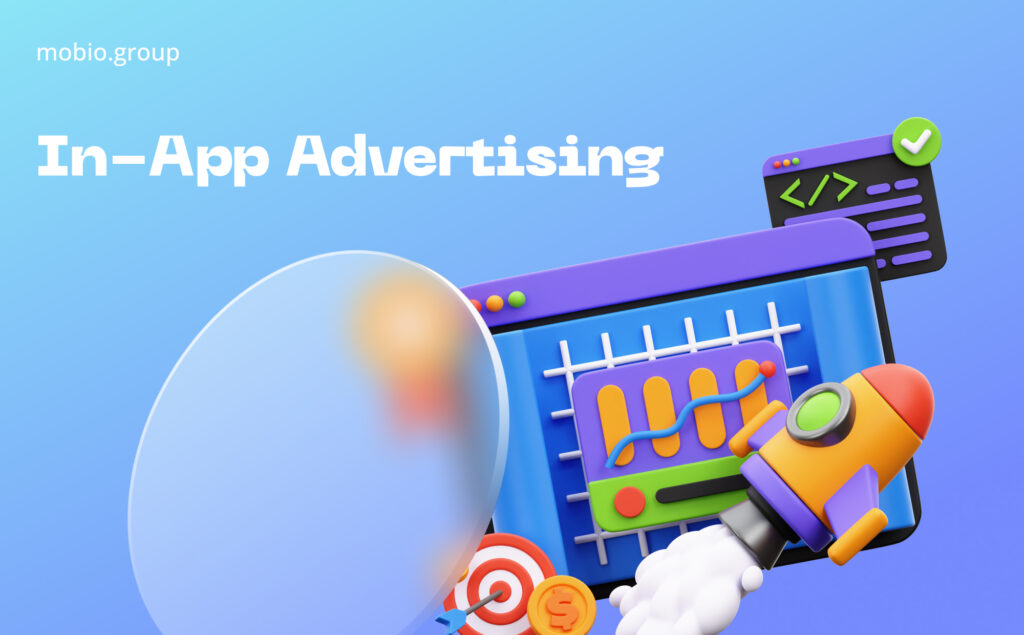
The in-app monetization model involves using non-paying users to generate revenue from the app. Users get access to all the features of the product at no cost, provided they are willing to view ads while using the app.
The ad placement process is done through an ad network that acts as an intermediary between publishers and advertisers. Some of the leading ad networks include Google Ads, IronSource, AdMob, Adcolony, Jumptap, Meta, Bing Ads, Adcash, Mojiva and others. (Performance Index of media sources from AppsFlyer in our article).
The main in-app ad formats are:
1. Intermediate (interstitial) ads
These are ads that spontaneously appear on the screen while using the app. They can be presented as static images or dynamic videos and usually appear during natural pauses, for example, between levels of a game or stages in a learning app. However, such ads may be perceived by users as disturbing and annoying, especially when it is impossible to close it.
2. Rewarded video ads
This type of ad provides an option — users can voluntarily view ads in exchange for rewards or bonuses in the form of items, currency, points, or other benefits.
3. Gaming Ads
These ads invite users to actively interact with the advertised application by asking them to test a mini-version before installing it. These interactive ads are categorized as interstitial ads, but boast higher engagement rates due to their engaging nature.
4. Banner ads
These animated or static ads appear in set areas of the screen, often at the top or bottom and close on click or after purchasing an enhanced version of the app. The downside is the developing “banner blindness” of users, in which there is a subconscious ignoring of such ad units.
5. Offerwalls
Offer stands represent an alternative opt-in format. Users, most often gamers, are asked to perform a series of actions such as taking surveys, installing other apps, or making purchases in them in exchange for rewards.
Care must be taken when in-app monetization is involved. Users do not have a burning love for ads, rather they tolerate them for the opportunity to use the app for free. An unbalanced display of ads can cause lower rankings in app store reviews and a large number of negative reviews.
Hybrid Monetization Strategies
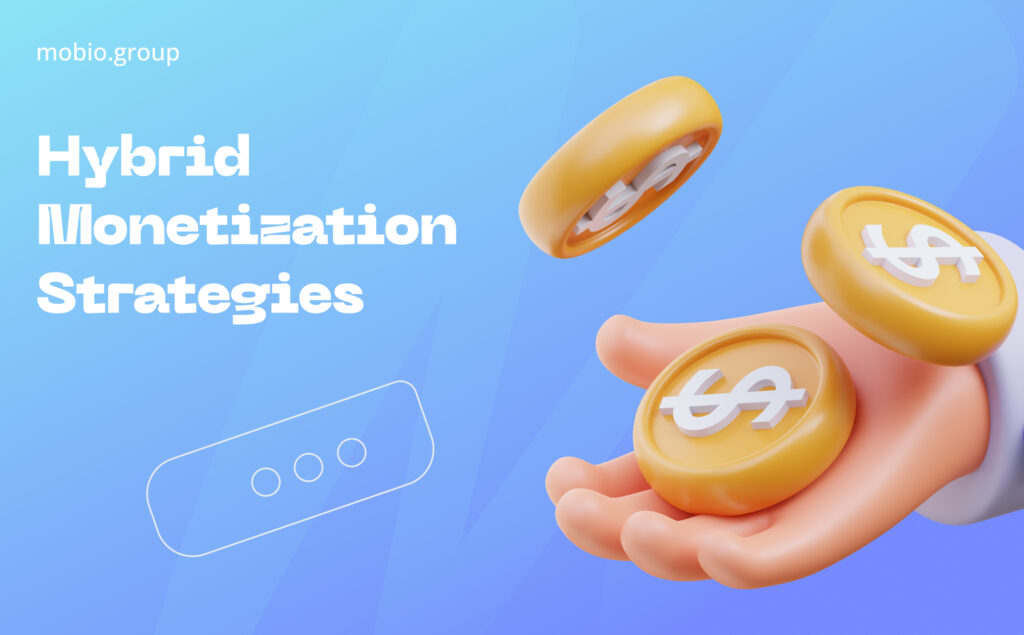
The key advantage of mobile app monetization is its adaptability — there is no need to stick to a single model. Moreover, you can skillfully combine several models, and this approach is commonly referred to as a hybrid monetization strategy, where one of the models plays the role of the main strategy and the others serve as additional sources of revenue. The key to success lies in skillfully balancing multiple revenue streams.
The most common combinations of hybrid monetization are:
In-App Ads + In-App Purchases
In this duo, the app generates revenue from both paying and non-paying users. In most cases, in-app purchases play the main role, while in-app ads provide additional value. Moderation is important here: an overload of ads and offers can ruin the user experience.
In-App Purchases + Subscriptions
In-app purchases offer users various options to improve the gameplay or experience. Highly engaged users who want continuous benefits and improvements design subscriptions.
In-App Purchases + In-App Ads + Subscriptions
A growing number of app owners are boldly combining all three models to appeal to a wide range of users, both paying and non-paying. In this scenario, in-app purchases tend to be the primary strategy, with the other two models serving as additional revenue streams. With three streams in place, careful balance becomes paramount.
Whether you choose in-app purchases, subscriptions, or a hybrid strategy, the key is to find what resonates with your target audience. This insight not only contributes to the right monetization choices, but also to user satisfaction and future app growth. Further promotion of the app depends on this very resonance with the audience. It’s about attracting all the right users, retaining them and continually expanding the user base. Our mobile marketing agency specializes in effective mobile app promotion, ensuring that they reach their target audience and continue to thrive.
FAQs
1. What is the biggest mistake made when choosing a monetization strategy?
One common mistake is not considering the nature of the target audience and app categories. What is appropriate for a gaming app may not be appropriate for a productivity app. It is critical to align your strategy with user behavior and preferences. For example, hyper casual games mostly use In-App Ads because players spend a short amount of time playing them for fun, and streaming services most often rely on subscriptions.
2. Is it possible to change the monetization strategy once the app is launched?
Yes, you can change your monetization strategy, but you should do it thoughtfully. Make changes gradually, communicate updates to your user base, and closely monitor user feedback and metrics to ensure a smooth transition without alienating existing users.
3. What factors should be considered when pricing in-app purchases or subscriptions?
Pricing should reflect the value you provide to users. Consider the unique features of your app, the competitive landscape, and the amount your target audience is willing to pay. A/B testing can help fine-tune pricing to achieve optimal revenue.
4. How do I analyze the success of my monetization strategy?
Success metrics can vary depending on your strategy, but common metrics include revenue per user (ARPU), customer lifetime value (LTV), conversion rates, and user reviews. Analyze these metrics regularly to make informed adjustments to your monetization approach.
5. Are there legal or ethical issues with some monetization methods?
Monetization methods in mobile apps can sometimes raise legal and ethical issues, especially when they cross boundaries that may violate user rights or privacy. Common problems:
- Misleading advertising. Example: a fitness app promising “instant abs” through in-app purchases that actually only provide generic workout programs.
- In-app purchases that target children. Example: a gaming app that offers children enticing virtual items without properly informing parents of the potential costs.
- In-app purchase app appeals that encourage compulsive spending. Example: a casino game app that uses psychology to encourage persistent in-app purchases, potentially leading to gambling-related problems.
- Opacity of fees. Example: an app in which subscription fees are hidden in small print, making it difficult for users to understand the actual costs.


